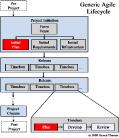No battle plan survives contact with the enemy
Plans are nothing, but planning is everything
Field Marshal Helmuth Graf von Moltke
 I believe that Agile Project Management provides certainty of delivery. Planning is what lets us answer the question “When will you be finished?”. Planning is, however, just the start of the process. As Moltke pointed out planning is more important that the plan because once you start the project you’ll find the plan is wrong and you have to adapt. All plans need revisiting and you will have to use Agile Project Control, Agile Change Management, and Agile Risk Management to get the promised certainty of delivery.
I believe that Agile Project Management provides certainty of delivery. Planning is what lets us answer the question “When will you be finished?”. Planning is, however, just the start of the process. As Moltke pointed out planning is more important that the plan because once you start the project you’ll find the plan is wrong and you have to adapt. All plans need revisiting and you will have to use Agile Project Control, Agile Change Management, and Agile Risk Management to get the promised certainty of delivery.
Continue reading